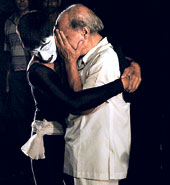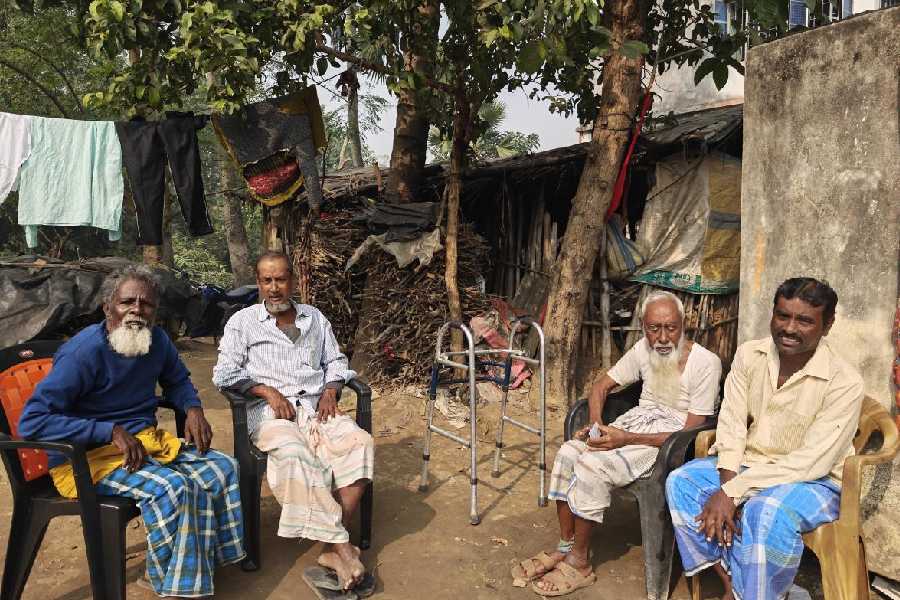 |
 |
| A student (in costume) consoles Jogesh Dutta after his last performance; (below) Dutta in his younger days. (Bishwarup Dutta) |
It was a picture of surrender, just as he had wanted it to be. Only he may not have realised how painful this goodbye would be.
The Rabindra Sadan show of August 21 marked the last stage performance of the Indian pioneer of mime, Jogesh Dutta. The packed audience watched him do the chor routine and his students render the characters and situations from everyday life he has made famous.
With the National Anthem playing in the background Jogesh Dutta, age 76, dressed in white, came before the audience to lay down his mime costume. As the curtains came down he was alone on stage. But then, he was also the mentor surrounded by students, their faces painted, ready for the next show.
“I will live now as a teacher and a friend of those who have no one to turn to,” said Dutta. For him life has come full circle and he is in a position to help out others who have begun life like him, in poverty and pain.
Dutta’s flat on the 11th floor of Naba Kailash on Ballygunge Circular Road is tastefully decorated and shows no sign of the struggle that he has gone through.
One of Dutta’s earliest memories is of his family waking up as homeless Bangladeshi refugees on the Sealdah railway platform even as the country celebrated Independence. His parents died in quick succession leaving him, his four brothers and a sister to the mercy of distant relatives. As a 15-year-old Dutta boarded a train just wanting to “leave it all behind,” but the ticket checker decided that he had to get off at Rampurhaat.
He spent two years washing dishes at a roadside tea stall, working in a grocery shop and keeping the log at a construction site in Farakka, longing all the while to see his family.
His mejda (elder brother, who was a puppeteer) Suresh Dutta caught him loitering around their home in Salkia, Howrah. The prodigal son was allowed to share the single room with the family.
Soon Jogesh built a reputation as a professional kautuk artiste reciting poems and imitating people at college and office functions at Mahajati Sadan, Bakers Hall and University Institute Hall. As founder-member of Sundaram he acted in two early plays: Pather Panchali and Mrityur Chokhe Jol.
One evening in 1956, sitting by Rabindra Sarobar, he noticed how even though he couldn’t hear anybody he could make out what kind of people had assembled there. “At home I created my first mime item, that of a lady dressing before a mirror.” Introduced as “nirbak kautuk” or a silent comic piece, the item was a huge success. Dutta therefore added more silent items to his repertoire not knowing anything about mime, its special costume and make-up or even its place in Bharata’s Natyashastra. When Yuba Sangha arranged a foreign tour for him Dutta was able to compare notes with other artists, hone his style and discover how different it was. He called his new art Mukabhinay.
Over the years Dutta has taught and performed at countless venues across the globe, won awards and recognition. In 1971 his research centre Podaboli expanded into The Jogesh Mime Academy affiliated to the Sangeet Natak Akademi and Rabindra Bharati University. The four-year course today attracts students from India, Bangladesh, Nepal and Switzerland. Mime is also an optional vocation at Dutta’s Silent Village for the physically challenged.
“Players retire, why can’t artists? I think it is best to retire while one is still at the top. My doctor advises complete rest. This way no one can come up after a show and say: ‘It wasn’t as good as it had been’.”
Lifting an imaginary cup from the table Dutta mimes a person enjoying his drink, savouring every sip, then gently sets down the cup now much lighter because it is empty. But Calcutta wishes for an encore.










